
Riesling is a white grape variety that originated in the Rhine region. Riesling is an aromatic grape variety displaying flowery, almost perfumed, aromas as well as high acidity. It is used to make dry, semi-sweet, sweet, and sparkling white wines. Riesling wines are usually varietally pure and are seldom oaked. As of 2004, Riesling was estimated to be the world's 20th most grown variety at 48,700 hectares, but in terms of importance for quality wines, it is usually included in the "top three" white wine varieties together with Chardonnay and Sauvignon blanc. Riesling is a variety that is highly "terroir-expressive", meaning that the character of Riesling wines is greatly influenced by the wine's place of origin.
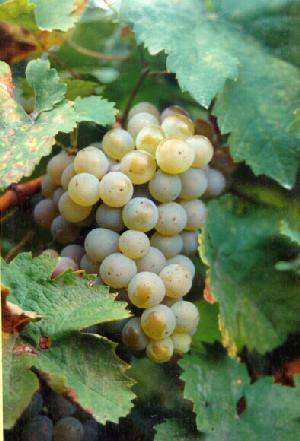
Liebfraumilch or Liebfrauenmilch is a style of semi-sweet white German wine which may be produced, mostly for export, in the regions Rheinhessen, Palatinate, Rheingau, and Nahe. The original German spelling of the word is Liebfrauenmilch, given to the wine produced from the vineyards of the Liebfrauenkirche or "Church of Our Lady" in the Rhineland-Palatinate city of Worms since the eighteenth century. The spelling Liebfraumilch is more common on labels of exported wine.

Mosel is one of 13 German wine regions (Weinbaugebiete) for quality wines , and takes its name from the Mosel River. Before 1 August 2007 the region was called Mosel-Saar-Ruwer, but changed to a name that was considered more consumer-friendly. The wine region is Germany's third largest in terms of production but some consider it the leading region in terms of international prestige.

Late harvest wine is wine made from grapes left on the vine longer than usual. Late harvest is usually an indication of a sweet dessert wine, such as late harvest Riesling. Late harvest grapes are often more similar to raisins, but have been naturally dehydrated while on the vine.
Beerenauslese is a German language wine term for a late harvest wine with noble rot. Beerenauslese is a category in the Prädikatswein category of the Austrian and German wine classifications, and is a category above Auslese. Beerenauslese wines, often called "BA" for short, are usually made from grapes affected by noble rot, that is "botrytized" grapes.

German wine is primarily produced in the west of Germany, along the river Rhine and its tributaries, with the oldest plantations going back to the Roman era. Approximately 60 percent of German wine is produced in the state of Rhineland-Palatinate, where 6 of the 13 regions (Anbaugebiete) for quality wine are situated. Germany has about 103,000 hectares of vineyard, which is around one tenth of the vineyard surface in Spain, France or Italy. The total wine production is usually around 10 million hectoliters annually, corresponding to 1.3 billion bottles, which places Germany as the eighth-largest wine-producing country in the world. White wine accounts for almost two thirds of the total production.
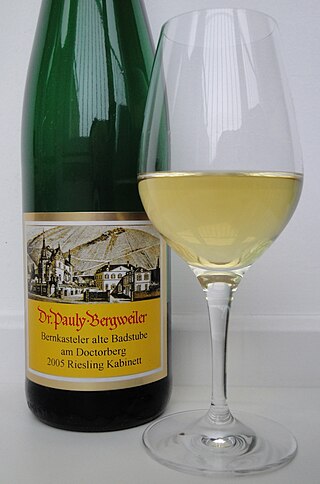
Kabinett, or sometimes Kabinettwein, is a German language wine term for a wine which is made from fully ripened grapes of the main harvest, typically picked in September, and are usually made in a light style. In the German wine classification system, Kabinett is the lowest level of Prädikatswein, lower in ripeness than Spätlese.

Spätlese is a German wine term for a wine from fully ripe grapes, the lightest of the late harvest wines. Spätlese is a riper category than Kabinett in the Prädikatswein category of the German wine classification and is the lowest level of Prädikatswein in Austria, where Kabinett is classified in another way. In both cases, Spätlese is below Auslese in terms of ripeness. The grapes are picked at least seven days after normal harvest, so they are riper and have a higher sugar content. Because of the weather, waiting to pick the grapes later carries a risk of the crop being ruined by rain. However, in warm years and from good sites much of the harvest will reach Spätlese level.
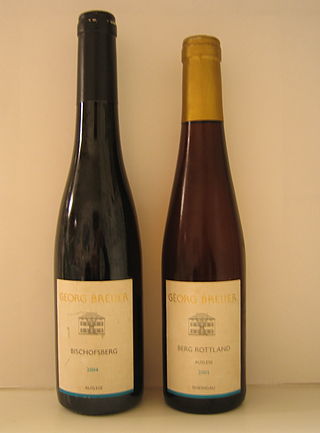
Auslese is a German language wine term for a late harvest wine and is a riper category than Spätlese in the Prädikatswein category of the Austrian and German wine classification. The grapes are picked from selected very ripe bunches in the autumn, and have to be hand-picked. Generally Auslese wine can be made in only the best harvest years that have been sufficiently warm. A small proportion of the grapes may be affected by noble rot in some regions although this never dominates the character of the wine. Rheingau winemaker Schloss Johannisberg is generally credited with discovering Auslese wine in 1787.
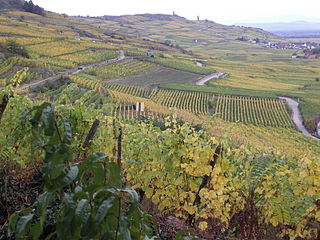
Alsace wine or Alsatian wine is produced in the Alsace region in France and is primarily white wine. Because of its Germanic influence, it is the only Appellation d'Origine Contrôlée region in France to produce mostly varietal wines, typically from similar grape varieties to those used in German wine. Along with Austria and Germany, it produces some of the most noted dry Rieslings in the world as well as highly aromatic Gewürztraminer wines. Wines are produced under three different AOCs: Alsace AOC for white, rosé and red wines, Alsace Grand Cru AOC for white wines from certain classified vineyards and Crémant d'Alsace AOC for sparkling wines. Both dry and sweet white wines are produced.
The Oechsle scale is a hydrometer scale measuring the density of grape must, which is an indication of grape ripeness and sugar content used in wine-making. It is named for Ferdinand Oechsle (1774–1852) and it is widely used in the German, Swiss and Luxembourgish wine-making industries. On the Oechsle scale, one degree Oechsle (°Oe) corresponds to one gram of the difference between the mass of one litre of must at 20 °C and 1 kg. For example, must with a specific mass of 1084 grams per litre has 84 °Oe.
The glossary of wine terms lists the definitions of many general terms used within the wine industry. For terms specific to viticulture, winemaking, grape varieties, and wine tasting, see the topic specific list in the "See also" section below.
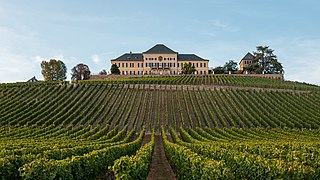
Schloss Johannisberg is a castle and winery in the village of Johannisberg to the west of Wiesbaden, Hesse, in the Rheingau wine-growing region of Germany. It has been making wine for over 900 years. The winery is most noted for its claim to have "discovered" late harvest wine. The palace is a venue of the Rheingau Musik Festival, made available by co-founder Tatiana von Metternich-Winneburg.

A number of German wine auctions are held each year, where the premier German wine producers auction off some of the best young wines, as well as some older wines. Most auctions are arranged by the regional associations of Verband Deutscher Prädikatsweingüter (VDP). These auctions differ from wine auctions on the second-hand market held by auction houses, where collectible wines are sold by private or corporate owners, since it is "first hand" wines that are sold.

Nahe is a region (Anbaugebiet) for quality wine in Germany, along the River Nahe in the state of Rhineland-Palatinate. On the region's 4,155 hectares of vineyards in 2008, white wine grapes dominate with 75% and Riesling is the most common variety with 27.2%. A characteristic of the Nahe region is that the soils are very varied owing to the region's volcanic origins.
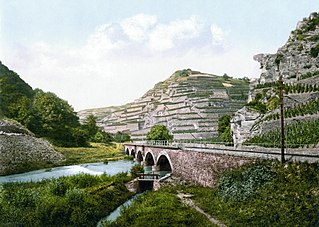
Ahr is a wine region (Anbaugebiet) for quality wine in Germany, and is located in the valley of the river Ahr, a tributary of Rhine, and is situated in the federal state of Rhineland-Palatinate. With only 558 hectares of vines as of 2008, it is one of smaller of Germany's 13 regions. Despite its northern location it primarily produces red wines, and red grape varieties account for 86% of the vineyard area, which is more than in any other German wine region.
Mittelrhein is a region (Anbaugebiet) for quality wine in Germany, and is located along a 120 km stretch of river Rhine in the tourist portions of the Rhine region known as Middle Rhine. On the left bank of Rhine, vineyards begin immediately downstream of the Nahe estuary and last until Koblenz. On the right bank, vineyards begin where Rheingau ends and last until 8 kilometers south of Bonn, in the Siebengebirge. Parts of the Rhine Gorge, a UNESCO World Heritage since 2002, make up the southern part of Mittelrhein.
Optima is a white wine grape that was created by viticulturalist Peter Morio at the Geilweilerhof Institute for Grape Breeding in the Palatinate in 1930. Morio crossed a Riesling x Silvaner cross with Müller-Thurgau. The Riesling x Silvaner is sometimes mentioned as Rieslaner, but more often just as "a Riesling x Silvaner". Due to the random element of genetic recombination involved in sexual reproduction of plants, no two crosses of the same parent grape varieties will be identical, so there is a difference between the Riesling x Silvaner cross Rieslaner, and each other such cross.

Schloss Vollrads is a castle and a wine estate in the Rheingau wine-growing region in Germany. It has been making wine for over 800 years.

Districtus Austriae Controllatus, DAC, is a classification for regionally typical quality wine in Austria. It is loosely modelled on the French Appellation d'Origine Contrôlée (AOC) system, and is coupled with a ripeness-based classification scale that shares a lot of nomenclature with the German Prädikat system. Thus, if a label states the winegrowing region followed by the letter combination “DAC” we are talking about a regionally typical quality wine. All Austrian quality wines have a round, red and white striped "Banderole" on the capsule, which ensures, that it has been inspected and approved by the government tasting authority and fulfills the requirements for “Qualitätswein”, such as maximum yields per hectare, minimum must weight and alcohol levels and guaranteed origin of the grapes.





















